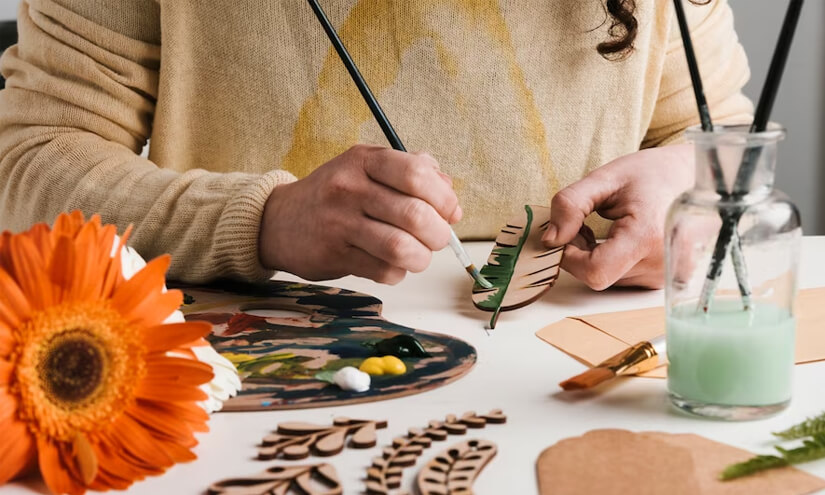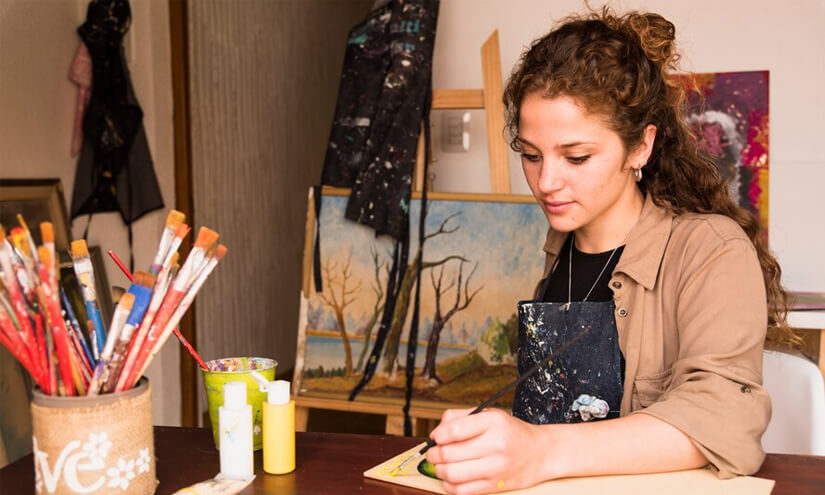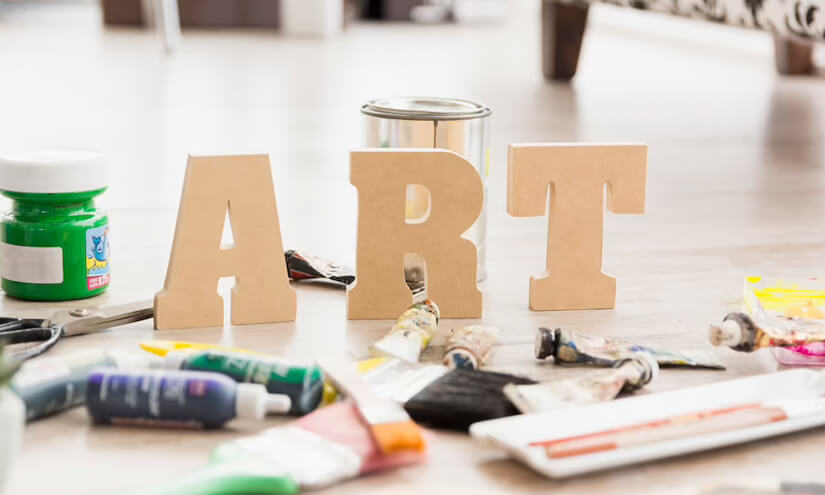Do you have these questions in your mind?
- How to start a small craft business online?
- How to start craft business from home?
- What crafts sell well in USA and UK?
- Do you need a license to sell handmade crafts US UK?
In this article, you will find answers to all your questions. So please grab a cup of coffee, and let’s get started.
Table of Contents
In ancient mythology, the gods were often depicted as skilled craftsmen who created beautiful objects and works of art. From the Greek god Hephaestus, who forged incredible weapons and jewelry, to the Egyptian goddess Isis, who was a master weaver and textile artist, the divine beings were revered for their artistic abilities.
But what if the ability to create beautiful things wasn’t just reserved for the gods? What if mere mortals could tap into this same creative energy and use it to build successful businesses and fulfilling lives?
So why not take a page from the book of the gods and tap into your own creative potential? With hard work, dedication, and a little bit of divine inspiration, you too can become a master crafter and build a business that’s both profitable and fulfilling.
What is Craft Business?
A craft business involves creating and selling handmade products. This can include many items, such as jewelry, ceramics, textiles, woodworking, paper goods, and more. Craft businesses may operate online through e-commerce platforms, sell products at local markets and craft fairs, or run out of a brick-and-mortar store.
The craft business industry has grown significantly in the US and UK in recent years due to increased interest in unique and personalized products. Many people enjoy the experience of purchasing handmade items directly from the creator and supporting small businesses and local artisans. Some craft businesses focus on creating custom items for clients, while others offer a variety of pre-made products for purchase.
Craft businesses require skill, creativity, and dedication to produce high-quality items that attract customers. Successful craft business owners often have a strong passion for their craft and a willingness to learn and grow in their skills continually. Additionally, a solid understanding of marketing and business management can help a craft business thrive and grow over time.
Market Insight: Starting an arts and crafts business in the US or UK can be a great way to turn your creativity into a profitable venture. However, starting a business can be challenging, especially if you're new to the industry. There are several steps to consider, including researching your market, identifying your niche, creating a business plan, and determining your pricing strategy.

Types of Art and Craft Business Models
Many business models can be used in an arts and crafts business.
1. E-commerce:
This model involves creating an online store to sell your arts and crafts products to customers worldwide. You can use platforms like Etsy or Shopify to make your online store or sell on established marketplaces like Amazon or eBay.
2. Subscription:
This model involves creating a subscription-based service where customers pay a monthly fee to receive a box of your arts and crafts products every month.
This model works particularly well if you create products that can be used regularly, such as scrapbooking materials or knitting supplies.
3. Wholesale:
This model involves selling your arts and crafts products in bulk to other businesses, who then sell them to their customers.
This can be a great way to scale your business quickly, but you must be prepared to produce large quantities of products regularly.
4. Commission-based:
This model involves creating custom-made arts and crafts products for individual customers. You’ll need to work closely with each customer to understand their specific needs and preferences and create a unique product that meets their requirements.
This can be a lucrative business model, but it can also be time-consuming and require high skill and expertise.
5. Crowdfunding:
This model involves using crowdfunding platforms like Kickstarter or Indiegogo to raise funds for a specific arts and crafts project.
You’ll need to create a compelling campaign that showcases your product and its potential benefits to customers and then encourage people to support your project financially.
This can be a great way to get your business off the ground, but it requires a lot of marketing and promotion to be successful.
Pros and Cons of an Art and Craft Business
Here are some pros and cons of starting an art and craft business:
Pros:
- Creative fulfillment
- Flexibility
- Personal expression
- Direct customer interaction
- Diverse revenue streams
Cons:
- High competition
- Financial uncertainty
- Time-consuming
- Limited scalability
- Seasonal demand
Starting an art and craft business can be rewarding and fulfilling for those passionate about creativity and entrepreneurship. Still, it requires dedication, hard work, and a willingness to take risks and overcome challenges.

Art & Craft Business Investment
The investment required for an art and craft business will depend on the type of business, the scale of production, and the artisan’s individual needs and goals.
Here are some typical costs associated with starting an art and craft business:
1. Materials and supplies:
The cost of materials will depend on the type of products the artisan creates. Depending on the production scale, this can range from a few hundred dollars to thousands of dollars.
2. Equipment and tools:
Artisans may need to purchase equipment and tools to create their products. This can range from essential tools like scissors and glue to specialized equipment like kilns or printmaking presses. The equipment cost will depend on the type and quality of the tools needed.
3. Marketing and advertising:
Artisans may need to invest in marketing and advertising to attract customers. This can include creating a website, building a social media presence, and advertising in local publications. Costs for marketing and advertising can vary widely depending on the approach taken.
4. Business registration and legal fees:
Artisans may need to register businesses and pay legal fees to ensure they operate within local laws and regulations. The cost of registration and legal fees will vary depending on the location and type of business.
Overall, the one-time setup cost for an art and craft business can range from a few hundred dollars to tens of thousands of dollars, depending on the scale and scope of the company.

How much will you earn in Art and Craft Business?
The earning potential of an art and craft business can vary widely depending on the artisan’s skill level, the market demand for their products, and the scale of production.
Here are some factors to consider:
1. Sales volume:
The more products an artisan sells, the more revenue it will generate.
2. Profit margins:
The profit margins on art and craft products vary widely depending on the materials and production costs. Artisans with lower production costs and higher-priced products may have higher profit margins.
3. Market demand:
The demand for art and craft products can vary based on trends and consumer preferences. Therefore, artisans who create products that are in high order may be able to generate more revenue.
4. Pricing:
The pricing of art and craft products will depend on the materials used, the production process, and the perceived value of the products. Artisans who price their products correctly may be able to generate more revenue.
Overall, the earning potential for an art and craft business can range from a few hundred dollars per month to several thousand dollars per month, depending on the artisan’s skill level, production capabilities, and the demand for their products.
Looking for LOGO Design + Branding?
iMedia Ad Agency is an award wining Logo Design Company run by Sushant & Vijaya, offering professional logo designs for Start-ups / SMEs / Home Businesses Owners.
WHAT ALL YOU WILL GET IN YOUR LOGO PACKAGE?
- Full ownership of final Logo remains with the client
- 100% original logo artwork
- No internet copy-paste work
- Original sketch supplied
- Super High resolution Vector file formats
- Free 1 month logo backup support
- Telephone, chat, skype & email support
Get all Business Launch Solutions under one roof Logo, Corporate Identity, Invite, Stationary, Packaging, Broucher, Product Display, Web Design, Business Blog, Shopify Store, Startup Pitch Deck, Google SEO, Product Reviews, Business Articles, and Social Media Management.


Checklist of Equipment Needed for Art and Craft Business
The equipment required for an art and craft business can vary depending on the specific products being made and the production scale.
Here is a checklist of some essential equipment that may be required:
1. Tools:
Depending on the craft, various tools may be required, such as scissors, cutting mats, knives, needles, sewing machines, and other hand tools.
2. Materials:
Artisans must purchase raw materials for their craft, such as fabrics, yarn, paper, beads, paints, and other materials.
3. Workstations:
Artisans need a dedicated workspace, including tables, chairs, and storage units.
4. Packaging and shipping supplies:
If selling products online or in stores, artisans need packaging and shipping supplies such as boxes, envelopes, labels, and tape.
5. Safety equipment:
Some crafts may require safety equipment such as gloves, goggles, masks, and ventilation systems.
6. Computer and software:
A computer and software for managing orders, inventory, and accounting may be necessary for businesses that sell products online.
7. Marketing materials:
Artisans may need marketing materials such as business cards, product catalogs, and a website.
These are just some of the essential equipment that may be required for an art and craft business.
Artisans should research the equipment needed for their craft and production scale.

Types of Staff Needed to Start Art and Craft Business
Starting an art and craft business typically requires a team of skilled staff with diverse talents and expertise. Here are some types of staff you may need:
1. Artists/Craftsmen:
These are the creative people who design and make the products. Therefore, they should have the technical skills and creativity to produce high-quality art and crafts.
2. Marketing Specialists:
Marketing specialists help promote your business and products to your target audience. They may handle advertising, social media, email marketing, and other forms of outreach.
3. Salespeople:
Salespeople are responsible for selling your products to customers. Therefore, they should be knowledgeable about your products and able to answer customer questions.
4. Customer Service Representatives:
Customer service representatives are responsible for providing excellent customer service, handling complaints, and resolving issues.
5. Production Manager:
The production manager is responsible for overseeing the production process, ensuring that the products are made efficiently and at a high level of quality.
6. Financial Manager:
The financial manager is responsible for managing the financial aspects of the business, such as budgeting, accounting, and financial planning.
7. IT Support:
IT support personnel to maintain your computer systems, website, and other technology-related tasks.
8. Administrative Staff:
The administrative staff manages administrative tasks such as scheduling appointments, paperwork, and organizing meetings.
The specific types of staff you need will depend on the size and scope of your business.
You may not need all of these positions when starting, but as your business grows, you may need to hire additional staff to handle different areas of the company.
Trends & Challenges in the Art and Craft Business
Here are some current trends and challenges in the art and craft business:
Trends:
1. Sustainability
2. Personalization
3. Online presence
4. Collaborations
5. DIY culture
Challenges:
1. Competition
2. Pricing
3. Marketing
4. Copyright infringement
5. Work-life balance

List of Craft products in demand
The products and services offered by an art and craft business can vary depending on the specific craft and the target market.
- Jewelry
- Candles
- Pottery
- Clothing and accessories
- Knit and crochet items
- Paintings and prints
- Wooden furniture and home decor
- Personalized gifts and stationery
- Soap and bath products
- Glassware and ceramics
- Leather goods and accessories
- Metalwork and sculptures
- Quilts and blankets
- Beaded and wire-wrapped items
- Stained glass and mosaics
Here is a additional list of some cross selling products and services that could be offered:
1. Handmade crafts:
This could include various handmade items, such as jewelry, pottery, textiles, woodwork, and more.
2. Art supplies:
Selling art supplies such as paints, canvases, brushes, and drawing materials could be a profitable business.
3. Craft kits:
Offering craft kits for beginners or DIY enthusiasts can be a great way to introduce new customers to the craft.
4. Customization services:
Customizing services such as engraving, monogramming, or personalization can be value-added services for customers.
5. Workshops and classes:
Offering workshops and classes in various crafts can be a great way to generate income and create a community around the business.
6. Event decorations:
Creating custom decorations for weddings, birthdays, and other events can be a profitable niche market.
7. Restoration and repair services:
Offering restoration and repair services for antique and vintage items can be a niche business.
These are just a few examples of the products and services that an art and craft business can offer.
Entrepreneurs must research their target market and competitors to determine what products and services would be most successful for their business.

Service Rate Card of Art and Craft Business
The service rates for an art and craft business can vary depending on many factors, such as the type of service, the complexity of the project, and the materials used.
Here are some service rates for art and craft businesses in the UK and the USA:
1. Custom Design:
Rates may start at around $75 for a simple design and can go up to several hundred pounds for more complex projects.
2. Reproduction Services:
Reproducing a painting or print may cost around $50-$100, while producing a sculpture or 3D object may cost more.
2. Event Services:
Event services rates in the UK can range from $75-$200 per hour, depending on the type of event and the number of attendees.
3. Workshops and Classes:
Workshop and class rates in the UK can range from $50-$150 per person depending on the duration of the workshop or class and the materials required.
4. Retail Sales:
A handmade scarf may cost around $25-$50, while a hand-painted piece of pottery may cost around $50-$150.
To finalize a profitable pricing strategy for your Art and Craft business, consider these steps:
1. Identify your niche
2. Research the market
3. Develop a business plan
4. Register your business
5. Set up your workspace
6. Create a portfolio and products
7. Build a web presence
8. Market your business

Licenses in an Art and Craft Business
Running an art and craft business may require particular licenses and permits, depending on your location and the type of business you operate.
Here are some standard licenses and permits that you may need to obtain:
1. Business License:
A business license is a general license that allows you to operate a business legally. The requirements for obtaining a business license vary by state and local government but generally involve filling out an application and paying a fee.
2. Sales Tax Permit:
You may need a sales tax permit if you sell products directly to customers. This permit allows you to collect and remit sales tax on your sales. The requirements for getting a sales tax permit vary by state.
3. Zoning Permit:
A zoning permit may be required to operate your business from a commercial or residential space. This permit ensures that your business complies with local zoning regulations and can be obtained from your local government.
4. Health and Safety Permits:
If you operate a business involving food or personal care products, you may need health and safety permits. These permits ensure that your products are safe for consumption or use and can be obtained from your local health department.
5. Copyright and Trademark:
If you create original artwork or designs, you must protect your intellectual property by obtaining copyright or trademark protection. This can be done through the US Copyright Office or the US Patent and Trademark Office.
Researching the licensing and permit requirements for your specific location and type of business is essential to ensure you comply with all regulations.
You may also want to consult with a lawyer or accountant for guidance on obtaining the necessary licenses and permits.

FREE DOWNLOAD
Launch your Money Blog
Build a 24/7 money machine that you can create and grow from anywhere in the world you are…

Art and Craft Resources
Here are some of the top art and craft franchises in the UK and USA, based on their reputation, brand recognition, and success:
- The Creation Station
Provides art and craft classes for children and adults and parties and events. - Hobbycraft
Sells art and craft supplies and offers workshops and classes.
- Painting with a Twist
Offers painting classes for adults and parties and events. - Pinot’s Palette
Offers painting classes and events for adults and children. - Color Me Mine
Provides pottery painting classes and events for adults and children. - The Clay Cafe
Offers pottery painting classes and events for all ages.
Related Movies to Inspire you
Looking for some creative inspiration?
Enjoy these must-watch movies that are sure to leave you feeling inspired and motivated.
Joy (2015)
This movie is based on the life of Joy Mangano, a single mother who invented the Miracle Mop and became a successful entrepreneur in the home shopping industry.
The Founder (2016)
This movie tells the story of Ray Kroc, who turned the fast food chain McDonald’s into a global brand. The movie portrays the importance of attention to detail, innovation, and perseverance in building a successful business.
Blow the Man Down (2019)
This movie is set in a small fishing town in Maine and follows two sisters who inherit their mother’s craft supply store. As they try to keep the store afloat, they uncover dark secrets about the town.
Mona Lisa Smile (2003)
This movie is set in the 1950s and follows a free-spirited art teacher at a conservative women’s college who encourages her students to think outside the box and pursue their artistic passions.
Pride and Prejudice (2005)
While not directly about craft businesses, this movie is set in a time when embroidery and other needlework were considered important skills for women. The movie portrays the importance of creativity and skill in these crafts, as well as the social dynamics of the time period.
The Joy Luck Club (1993)
This film is based on a novel by Amy Tan and tells the story of four Chinese-American women and their relationships with their mothers. One of the characters, Ying Ying, is a skilled embroiderer who creates intricate designs. The film includes scenes of her working on her embroidery and passing her skills down to her daughter.

Get Inspired by These Talented Craft Artists
USA:
Jenice Jackson
She specializes in African American dolls and crafts.
Website: https://www.jenicejackson.com
Instagram: @jenicejacksondolls
Julie A. Schneider
She creates unique, handcrafted jewelry using a mix of materials like metals, stones, and beads.
Website: https://www.julieaschneider.com
Instagram: @julieaschneiderjewelry
Robyn Love
She makes handmade paper goods and stationery, including greeting cards, journals, and notebooks.
Website: https://www.robynlove.com
Instagram: @robynlovegrows
Terri Planty
She creates beautiful stained glass pieces, including sun catchers, lamps, and window panels.
Website: https://www.terriplanty.com
Instagram: @terriplantyglass
Steve and Karen Gerard
They specialize in woodturning and create a variety of functional items like bowls, platters, and vases.
Website: https://www.gerardwoodworks.com
Instagram: @gerardwoodworks
UK:
Emily Dawe
She makes unique and quirky ceramic homeware and decorative pieces.
Website: https://www.emilydawe.com
Instagram: @emilydaweceramics
Alison Hardcastle
She designs and prints beautifully crafted stationery, cards, and gift wrap.
Website: https://www.alisonhardcastle.co.uk
Instagram: @alisonhardcastle
Jennifer Collier
She creates one-of-a-kind textile sculptures and objects, using a range of materials such as paper, thread, and found objects.
Website: https://www.jennifercollier.co.uk
Instagram: @jennifercollierartist
Nicki Jarvis
She makes stunning contemporary jewellery using traditional silversmithing techniques.
Website: https://www.nickijarvisjewellery.co.uk
Instagram: @nickijarvisjewellery
Hatti Pattisson
She creates beautiful, hand-painted silk scarves and accessories, inspired by nature and the changing seasons.
Website: https://www.hattipattisson.com
Instagram: @hattipattisson
Conclusion
Crafting a business in the world of handmade goods can be both a rewarding and profitable venture. With endless possibilities and a growing demand for unique and personalized items, there has never been a better time to turn your creative passion into a thriving business.
By focusing on quality, marketing, and customer engagement, you can establish a loyal following and stand out in a crowded marketplace. Remember to stay true to your vision and create with purpose, and your craft business can become a fulfilling and successful venture.
So why not take that leap of faith and turn your crafting hobby into a thriving business in the vibrant markets of Craft Business? The possibilities are endless!

Want to Save Time in your Business Launch?
- How to Create a Business Plan
- What is Market Research, USP, Niche & Positioning
- How to find a suitable name for your business
- How to create your brand image (Logo + Branding)
- How to Register Your Business
- How to Register for Taxes
- How to get Licenses / Permits
- How to Open a Business Bank Account
- How to Get Business Insurance
- Which Payment Processing Terminal (POS) to buy
- How to get Funds for your Business
- How to do Sales & Marketing – Offline & Online
- Why have a Website / Blog / Social Media
- How to build & train your Dream Team
- How to provide Excellent Customer Service
- Buying an Old Business Vs Franchisee Vs Own Brand from Scratch
Handpicked inspirational Youtube videos for you
How I Built My Art Business from Online to Physical Store (Making Art Prints, costs, supplies) – YT Channel ‘PinoyHowTo’
5 Steps to Starting a Craft Business From Home – YT Channel ‘The DIY Mommy’
A. Yes, having a business plan is essential for any business, including an art and craft business. A business plan will help you clarify your business goals, identify your target market, develop a marketing strategy, and plan for the financial aspects of your business.
A. Pricing your products can be tricky, but it’s important to ensure that you are covering your costs and making a profit. Consider the cost of materials, labor, and overheads, and add a margin to ensure a profit. Research the market to see what similar products are selling for and adjust your prices accordingly.
A. Yes, selling your products online can be a great way to reach a wider audience and increase sales. Consider setting up an online store on platforms such as Etsy, Amazon Handmade, or Shopify, or using social media to promote your products and direct customers to your website.
A. Marketing is essential for attracting customers and growing your business. Consider using social media platforms such as Instagram and Facebook to showcase your products and engage with potential customers. Attend craft fairs and markets to showcase your products and network with other crafters. You could also consider advertising in local publications or collaborating with other businesses.
A. Yes, it’s important to have insurance to protect your business from potential risks such as accidents or damages. Consider getting liability insurance, property insurance, and product liability insurance to ensure that you are covered in case of an incident.




















